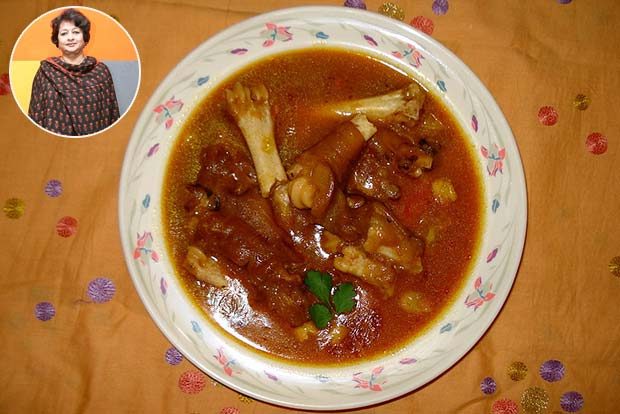Begin typing your search...
Dish that ‘trots’ down the path of Anglo-Indian history and heritage
A contemporary cuisine emerged in India, during the then British Raj, which fused the culinary heritage of the East and the West.

Chennai
This cuisine was ‘Anglo’ and ‘Indian’, neither too spicy nor too bland, but with a distinct flavour of its own. Indian khansamas (cooks) took aspects of British cuisine and amalgamated them with Indian methods of cooking to create this style, which has been present in India since the 1900s. One can find soups tempered with cumin and red chillies, roasts cooked in whole spices like cloves, pepper and cinnamon, rissoles and croquettes flavoured with turmeric and garam masala. Lime rice and rasams saw new avatars too. The first place to serve this food was the railways. First class waiting rooms used to always smell of inviting fragrances of the different dishes served.
My father was in the railways first and then the UN and was always touring in his luxurious saloon, which was a plush little house on wheels, or railway carriage, which used to be attached to trains to reach different destinations. I remember Kutino, our Anglo-Indian cook from Vepery, who used to accompany the carriage and dish out the most amazing food.
As we were vegetarians, non-veg food was cooked only when a VIP guest or friend accompanied my dad, or dropped in to meet my him. The late Air Marshal Denis La Fontaine, who was friends with my dad, would often drop in to the railway club or visit the saloon parked at a station, depending on where he was posted. Being an artist, he appreciated great cooking, especially fusion and creative. Food served on the trains and stations, was truly the essence of heritage and fusion cooking.
Ever since the first broad-gauge train chugged from Bori Bunder to Thane on April 16, 1853, the Anglo-Indian community has been involved in every aspect of the railways, especially creating the most popular and liked cuisine to be served at stations and on the trains. The late Air Chief always asked for sheep trotters or paya curry, which had its origin in Mughalai cuisine. Over the years, Anglo-Indian cooking became more Indian than British. Paya especially, was very popular all over India and in the south, it took on the hues and ingredients, which gave it a unique taste of the Dakshin. This dish is best served hot with appams, rice, rotis or freshly baked bread.
Paya or Lamb trotters curry
- Prep Time: 30 mins
- Cooking Time: 50 mins
- Serves: 6-8
- Calories per serve: 360
Ingredients
Lamb trotters well-rinsed 12 | Turmeric powder (haldi) 1 tsp. | Coriander powder (dhania) 1 tbsp. | Red chilli powder: 1.5 tbsp. | Rice flour: 1 tbsp. | Salt: to taste | Sesame oil: 1/4 cup or 2 tbsp. | Ginger: 1 big piece | Garlic: 8 cloves | Red onions: 2 chopped finely | Tomato: 1 big, pureed | Cinnamon stick: 3 | Cloves: 2 pieces | Star anise: 2 pieces | Badi elaichi: 3 | Fennel seeds: 1 tsp. | Cumin: 1 tsp. | Pepper pods: 1 tsp | Green chilli paste: 1 tsp. | Green coriander leaves: 1 tbsp. | Thick yogurt: 1/2 cup | Cumin powder: 1 tsp. | Coriander powder: 1 tsp.
Method
- After washing the trotters well, place in a large pressure cooker and add enough water to completely submerge the trotters. Cook on a low flame for 20-30 minutes.
- Once you are done pressure cooking, transfer all of it including the mutton broth, into a large vessel and add the dry spice powders (turmeric, coriander, cumin and red chilli powder) and salt.
- Place a big pan on medium heat, pour a tbsp. oil, pour all the contents in it and cook on with the lid on for at least 10 minutes or more. This will help the trotters to absorb the basic flavours.
- Meanwhile, in a kadai, heat a tbsp. of cooking oil. Once it is hot, add the chopped onions and sauté on medium heat until the onions caramelise and are browned a bit.
- Add these caramelised onions in a mixer-grinder once it is cool along with coriander leaves, ginger, garlic, cinnamon, fennel seeds, pepper, cumin, cardamom, green chillies, a little coriander and cloves. Add a little bit of water and grind into a fine paste.
- Grind the tomato into a puree.
- Add the ground masala to the pan where the paya is cooking and add rice flour, made into a smooth paste — stir well to coat all the pieces. Add the well-beaten yogurt and tomato puree to this.
- Sauté for 5 minutes. If needed, you may add more water to set the consistency based on your preference. Check for spices and salt level and adjust accordingly.
- Cook on a low flame for 15-20 minutes more, with intermediate stirring. Close the lit immediately after stirring. Continue cooking until that the masala is cooked and any residual, raw smell disappears.
- If meat is not cooked very well, leave it for another 10 minutes in the cooker.
- Once it is done, serve hot with any of the breads mentioned in the article.
Kitchen Tip
- Ensure when you buy the trotters that they have been cleaned well and meat on it is fresh. Make sure you soak it in hot water with turmeric and lime before washing
- Pressure cooking is practical for today, though the tastiest paya would be if cooked on firewood.
— The writer is a chef and author of Festive Offerings to the Gods
Visit news.dtnext.in to explore our interactive epaper!
Download the DT Next app for more exciting features!
Click here for iOS
Click here for Android
Next Story



